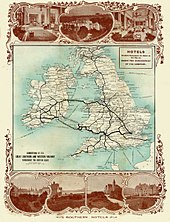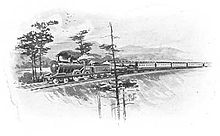Great Southern and Western Railway
 GS&WR coat of arms, Irish State Coach | |
| Dates of operation | 1844–31 December 1924 |
|---|---|
| Successor | Great Southern Railways |
| Track gauge | 1,600 mm (5 ft 3 in) |
| Length | 1,100 miles (1,800 km) |
The Great Southern and Western Railway (GS&WR) was an Irish gauge (1,600 mm (5 ft 3 in)) railway company in Ireland from 1844[1] until 1924.[2] The GS&WR grew by building lines and making a series of takeovers, until in the late 19th and early 20th centuries it was the largest of Ireland's "Big Four" railway networks. At its peak the GS&WR had an 1,100-mile (1,800 km) network, of which 240 miles (390 km) were double track.[3]

GSWR Ireland route map, circa 1902

GSWR British Isles connections map, circa 1902
The core of the GS&WR was the Dublin Kingsbridge – Cork main line; Ireland's "Premier Line", and still one of her most important main line railways. The company's headquarters were at Kingsbridge station. At its greatest extent the GS&WR included, in addition to the Dublin – Cork main line, the Dublin – Waterford and Mallow – Waterford lines and numerous branch lines.
Contents
1 Dublin – Cork Main Line
2 Expansion and competition
3 Waterford, Limerick and Western Railway
4 GS&WR hotels
5 GS&WR strike
6 Lombardstown train crash
7 GS&WR routes today
8 Great Southern Railways
9 Córas Iompair Éireann
10 GS&WR locomotive engineers
11 See also
12 References
13 Sources and further reading
Dublin – Cork Main Line
William Dargan, Ireland's foremost railway contractor, built much of the GS&WR's main line and a number of its other routes.
Construction of the Dublin – Cork main line began in January 1845.[4] The project included a branch line to Carlow, which was completed in August 1846.[4] In July 1848 the main line reached Limerick Junction, where it met the Waterford and Limerick Railway and thus linked Dublin and Limerick by rail.[5]
In October 1849 the main line reached the outskirts of Cork, where the GS&WR opened a temporary terminus at Blackpool.[5] The final 1-mile (1.6 km) of line from Blackpool to the centre of Cork includes a 1,355-yard (1,239 m) tunnel and was not completed for another six years.[6] Services through the tunnel began in December 1855, running to and from a second temporary terminus beside the River Lee.[6] Finally the present Cork terminus in Glanmire Road opened in July 1856.[6]
Expansion and competition

Corridor Train of the GS & WR.
The Irish South Eastern Railway opened between the GS&WR station at Carlow and Bagenalstown in 1848 and reached Lavistown in 1850.[7] From the outset the ISE was worked by the GS&WR.[7] The Waterford and Kilkenny Railway had already reached Lavistown, and thus completion of the ISE enabled GS&WR services to reach Kilkenny.[7] The W&KR reached Waterford in September 1854[8] but its relations with the GS&WR were poor,[9] which impeded traffic between Dublin and Waterford by this route. In 1877 the W&KR took over the Central Ireland Railway and became the Waterford and Central Ireland Railway.[10] The GS&WR took over the W&CIR in 1900,[11] thus belatedly bringing the rail route between Dublin and Waterford under the control and operation of a single company.
The GS&WR competed with the Midland Great Western Railway for many years. Both ran services between Dublin and the west of Ireland: the GS&WR running southwest to Limerick, Cork and Waterford, and the MGWR running west to Galway, Westport, Ballina, and Sligo. The GS&WR also had designs on rail traffic to the west of Ireland. In 1859 the GS&WR opened a branch line from the Dublin – Cork main line to Athlone where it connected with the MGWR's Dublin – Galway main line.[12] In the latter half of the 20th century Córas Iompair Éireann made this GS&WR branch part of its Dublin – Galway main line.
Waterford, Limerick and Western Railway
In 1901 the GS&WR bought the Waterford, Limerick and Western Railway,[13] which gave it both the Waterford – Limerick – Athenry – Claremorris – Collooney cross-country route and the North Kerry Line and branches. The WLWR, recently dubbed the Western Rail Corridor, crossed MGWR territory. It complemented the radial MGWR lines from Dublin, enabling Limerick – Galway and Galway – Sligo traffic, and linked intermediate destinations in the west of Ireland. For a very short time[when?] the MGWR exercised running powers over the Athenry – Limerick section of this route.
GS&WR hotels

The Great Southern Railway Terminus in Killarney, Co. Kerry. Circa 1890
In an effort to encourage tourism the Killarney Junction Railway, which was operated by the GS&WR, opened a hotel next to Killarney station. This was in 1854, which made it the first railway-owned hotel in Ireland[14] and one of the first of its kind in the World.[citation needed] In the following years the GS&WR established further hotels in County Kerry at Caragh Lake, Kenmare, Parknasilla and Waterville.[15] The company also owned small commercial hotels at Limerick Junction and near its stations in Dublin and Cork.[15]
In 1925 the hotels became part of Great Southern Hotels, a subsidiary of Great Southern Railways. The Great Southern Hotels Group was dissolved in 2006, when its hotels were sold off separately to private investors.
GS&WR strike
In September 1911 the workers of the Great Southern and Western Railway went on strike nationally after two checkers at Kingsbridge goods station in Dublin were suspended for refusing to handle timber that had been delivered by "blackleg" lorry drivers during a strike by the timber merchant's workers.[16] The British Army was brought in to guard tracks and trains, and Protestant strike-breakers from elsewhere in Ireland to do the work of the strikers. The strike was savagely broken in two months, with the railway's proprietor, William Goulding, sacking 10% of the workers for their participation in the strike. Goulding told his associates, "Now that we have the men defeated, we'll never have any more trouble."
Lombardstown train crash
A year after the strike, on 5 August 1912 at 8.50pm, an excursion train from Killarney crashed in Lombardstown, near Mallow in Cork. The driver had been on duty from 3.50am. Of the 200 passengers on board, 96 were seriously injured.
GS&WR routes today
GS&WR routes remain some of the most heavily used in Ireland, linking Dublin with Limerick, Cork, and Waterford. The coats of arms of these cities still adorn the facade of Heuston Station.
Great Southern Railways
An Act passed by the Dáil Éireann in 1924 merged the GS&WR with the Midland Great Western Railway, the Cork, Bandon and South Coast Railway and most other railways wholly within the Irish Free State to form the Great Southern Railway.[2] In January 1925 the GSR merged with the Dublin and South Eastern Railway to form the Great Southern Railways.[2] Cross-border railways were excluded from the mergers.
Córas Iompair Éireann
In 1945 further amalgamation with the Grand Canal Company and the Dublin United Tramway Company created Córas Iompair Éireann ("Irish State Transport Company"). CIÉ was nationalised in 1950, but was divided into separate rail and road companies in 1987. Since then, the railways have been operated by Iarnród Éireann ("Irish Rail").
GS&WR locomotive engineers
At different times in its history the GS&WR variously used the titles Locomotive Engineer, Locomotive Superintendent or Chief Mechanical Engineer to describe the same post.[17]
- 1844–47 — John Dewrance[17]
- 1847–64 — George Miller[17]
- 1864–83 — Alexander McDonnell[17]
- 1883–86 — John Aspinall[17]
- 1886–96 — Henry Ivatt[17]
- 1896–1911 — Robert Coey[17]
- 1911–13 — Richard Maunsell[17]
- 1913–21 — E.A. Watson[17]
- 1921–23 — J.R. Bazin[17]
See also
- History of rail transport in Ireland
- Iarnród Éireann
- Rail transport in Ireland
References
^ Murray & McNeill (1976), p. 15.
^ abc Murray & McNeill (1976), p. 106.
^ Murray & McNeill (1976), p. 11.
^ ab Murray & McNeill (1976), p. 16.
^ ab Murray & McNeill (1976), p. 18.
^ abc Murray & McNeill (1976), p. 178.
^ abc Murray & McNeill (1976), p. 21.
^ Murray & McNeill (1976), p. 64.
^ Murray & McNeill (1976), pp. 33, 62–63.
^ Murray & McNeill (1976), p. 62.
^ Murray & McNeill (1976), p. 68.
^ Murray & McNeill (1976), p. 24.
^ Murray & McNeill (1976), p. 107.
^ Murray & McNeill (1976), p. 26.
^ ab Murray & McNeill (1976), p. 182.
^ "The Great Southern Railway Strike of 1911". theirishstory.com. 9 March 2011. Retrieved 18 April 2018..mw-parser-output cite.citation{font-style:inherit}.mw-parser-output .citation q{quotes:"""""""'""'"}.mw-parser-output .citation .cs1-lock-free a{background:url("//upload.wikimedia.org/wikipedia/commons/thumb/6/65/Lock-green.svg/9px-Lock-green.svg.png")no-repeat;background-position:right .1em center}.mw-parser-output .citation .cs1-lock-limited a,.mw-parser-output .citation .cs1-lock-registration a{background:url("//upload.wikimedia.org/wikipedia/commons/thumb/d/d6/Lock-gray-alt-2.svg/9px-Lock-gray-alt-2.svg.png")no-repeat;background-position:right .1em center}.mw-parser-output .citation .cs1-lock-subscription a{background:url("//upload.wikimedia.org/wikipedia/commons/thumb/a/aa/Lock-red-alt-2.svg/9px-Lock-red-alt-2.svg.png")no-repeat;background-position:right .1em center}.mw-parser-output .cs1-subscription,.mw-parser-output .cs1-registration{color:#555}.mw-parser-output .cs1-subscription span,.mw-parser-output .cs1-registration span{border-bottom:1px dotted;cursor:help}.mw-parser-output .cs1-ws-icon a{background:url("//upload.wikimedia.org/wikipedia/commons/thumb/4/4c/Wikisource-logo.svg/12px-Wikisource-logo.svg.png")no-repeat;background-position:right .1em center}.mw-parser-output code.cs1-code{color:inherit;background:inherit;border:inherit;padding:inherit}.mw-parser-output .cs1-hidden-error{display:none;font-size:100%}.mw-parser-output .cs1-visible-error{font-size:100%}.mw-parser-output .cs1-maint{display:none;color:#33aa33;margin-left:0.3em}.mw-parser-output .cs1-subscription,.mw-parser-output .cs1-registration,.mw-parser-output .cs1-format{font-size:95%}.mw-parser-output .cs1-kern-left,.mw-parser-output .cs1-kern-wl-left{padding-left:0.2em}.mw-parser-output .cs1-kern-right,.mw-parser-output .cs1-kern-wl-right{padding-right:0.2em}
^ abcdefghij Murray & McNeill 1976, p. 197
Sources and further reading
| Wikimedia Commons has media related to Great Southern and Western Railway. |
Murray, K.A.; McNeill, D.B. (1976). Great Southern & Western Railway. Dublin: Irish Railway Record Society. ISBN 0-904078-05-1.
O'Mahony, John; Praeger, R. Lloyd (1902). The Sunny Side of Ireland – how to see it by The Great Southern and Western Railway. Dublin: Alex Thom & Co.
